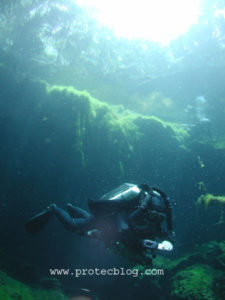I recently conducted a ccr cave cross over with Bill from Hawaii. The reason and purpose of the ccr cave cross over program is to combine ccr rebreather diving with cave diving. The term cross over is coming from the fact that a diver who had a cave diving education in open circuit as well as a ccr rebreather diving education who wishes to combine his cave diving experience with his rebreather experience.
The ccr cave cross over program to my knowledge (and I could be wrong) is only offered by two training agencies, IANTD and NSS-CDS. The prerequisites to participate in the ccr cave cross over is to be a trained cave diver with cave diving experience (75 cave dives with Bill) and to be a ccr rebreather diver with at least 20 dives and 35 hours on his unit (30 dives and 35 hours on his Classic Inspiration for Bill) to ensure that the skills of cave diving and rebreather diving a well rehearsed before bringing the two together.
The ccr cave cross over training program starts with a long discussion about bailout techniques and concepts as well as the advantages of diving a rebreather in water filled caves in terms of time we can spend and complex navigation we can do. Bailout is the alternative path to the surface in case your rebreather is non operational for whatever reason allowing us to return safely to the cave exit and surface. Bailout can be organized in three ways: open circuit (o/c), scr rebreather or ccr rebreather depending on a diver’s preference and recourses. Most divers opt for o/c as it is the easiest to obtain and simple. Team bailout concept versus individual bailout concept is a question about how much gas is carried by each individual, if the needed bailout volume to bring at least 1 ½ divers to the surface will be split in-between the divers or carried by each individual diver.
The complex and task loading training for the ccr cave cross over is coming from the fact that all cave diving related skills such as touch contact in zero viz, backup light exit, sharing gas in zero viz, lost line in zero viz plus the line protocol, team diving awareness and cave conservation have to be done using the rebreather doing them in the cave. The rebreather related skills such as partial and complete flood recovery, hypercapnia, hyperoxia, hypoxia, flying the unit manual as well as long horizontal o/c bailout swims have to be done in the cave.
All drills and skills are not new to the cross over student as he has done them many times before, only in separate environments and different breathing sources. The ccr cave cross over program is to bring the two together by first discussing the drills, then practice in openwater and then to practice them in the cave environment with safety and cave conservation in mind.
What will help the student is to have done as many cave dives as possible before the cross over as well as have done as many as possible rebreather dives on his unit. The basic operation of the rebreather should be second nature as we move from basic rebreather training and diving into a more advanced form of rebreather diving where we have two choices after an event on the rebreather which is either to stay o/c or go back onto the loop if we have figured out what is wrong with the unit, and go back onto the loop after a diluent flush to do a full or at least partial exit out of the cave using the rebreather.
Ccr rebreather cave diving is one of the most complex forms of diving due to the complex and task loading skills that need to be mastered by the ccr cave diver. To dive a rebreather in a water filled cave takes time to learn but can open new doors into the art of cave diving as we are not just going in and out of the cave anymore but are freed to stay much longer, as long as we stay within our bailout range and within save diving parameters including our consumables such as oxygen, diluent and Co2 absorbent duration and time limitations.
Save diving and greetings
Matt

